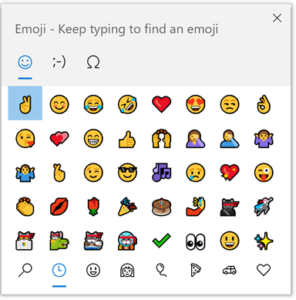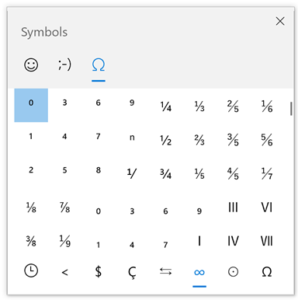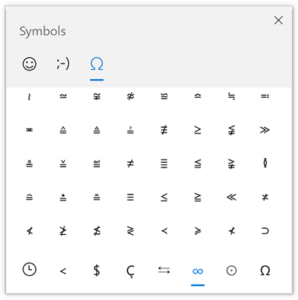The Windows key is used in a bunch of useful hot keys. Probably my favorite is Windows+Shift+s, which lets you copy any rectangular area on your screen(s) to the clipboard. I use this hot key a lot in describing application UI and other objects on the screen such as those in this post. I also use Windows+x y to see system info such as the name of the computer.
Another cool Windows hot key is “Windows+.” or “Windows+;”. Using Windows+Shift+s, I get the image
You can see related character displays by clicking on the characters in the bottom row. You can scroll these displays to see more characters. Clicking on a character not in the top or bottom row inserts that character into your active app.
Now click on the Ω in the top row of characters. You get
Here I’ve selected the ∞ page. This has many fractions, numeric subscripts and superscripts, ∞ of course, and, if you scroll down you can access myriad math symbols such as ∰. For example, you can see
I wish C++ would use some of those relational operators instead of being stuck in the 1960’s with ASCII sequences like “!=” instead of ‘≠’! Clicking on the ⨀ in the bottom row reveals still more math symbols.
The Assistive Technology (AT) program Narrator describes some of the features of these displays and knows how to speak the emoji characters. But it doesn’t know how to speak most of the advanced math symbols. In fact, I have a hard time speaking some of those symbols myself, like ⋈ (bowtie?)





Using a code font with appropriate ligatures will replace the ASCII sequences with prettier symbols. That has the added advantage that you don’t need to re-learn how to type code. 🙂
PS: You might want to get rid of the comment spam from “Nicolas Jack”; I can’t see any way to report it directly.
I know of only two common programming languages that can use mathematical symbols, APL and Juria.
It surely nice that more programming languages are able to use mathematical symbols!